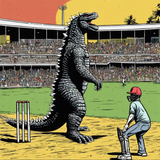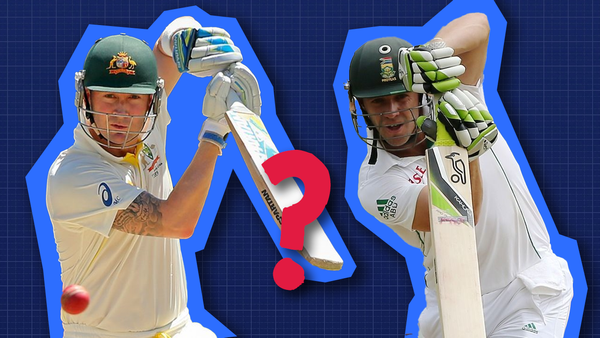Indian batters and their bowling saviours
From 2013 to 2019, all was good. Everyone was doing what they should. Then the batters decided to let the bowlers completely take over their job as well.

Apologies for the typo in the title of the previous email.
Download Hitwicket FREE for iOS/Android and build your dream team!
All stats via Statsguru, Cricmetric & the BCCI website. Updated as of Day 1 of the first India vs Bangladesh Test match.
For a long period of time, India's top order made a lot of runs. You may have heard of them. They're the ones on the back of all those shirts. The chants you hear, that's them as well. But a couple of years ago at home, they decided to stop making runs. The allrounders and 'almost' allrounders took over all the batting duties at home.

From 2013 to 2019, all was good. Everyone was doing what they should. Then the batters decided to let the bowlers completely take over their job as well.
The last five years when at home, India has the best batting from spots seven to nine in the world. And this is one of those things that needs a lot more context, right? Maybe it's because they're great and their top order is destroying bowling everywhere. Or maybe the top order has not done anything, so the lower order just has to make runs.

The issue though is when we look at the top six batters. Suddenly, Pakistan has the best batters at home, with Australia and Sri Lanka ahead of them. In what world does India want to be behind Pakistan and Sri Lanka on a graphic like this?

Now, conditions play a huge role in this. I'm pretty sure you and I could probably average about 25 when batting on some wickets in Pakistan. But when you have big names like India, heavy lies the crown.
But India have been making spin-friendly wickets for some time now, and it's much harder to bat. It is specifically the hardest between overs 21 and 40. Your numbers seven, eight, and nine are usually not going to come out to bat here. They are more likely to come out between overs 41 and 60, unless something has gone wrong, which does happen on occasion.

When the ball completely loses its lacquer and starts to go very soft, it is the best time to bat. There's nothing surprising about that, although we don't always look at Asian wickets this way. But the point is that you want to bat from overs 41 to 80, and not from 21 to 40.
Let's have a look at pace versus spin. Again, when the new ball keeps that lacquer on, you can handle it when you're batting in India. The minute the lacquer comes off and the ball is still hard, that is the worst time to bat. It doesn't really start to get good until that ball softens up right towards the end.

When the second new ball is taken, it gets really difficult to face spin again after 20 overs. The pattern that we are seeing here is the lacquer coming off the ball, but the ball staying hard, which allows it to grip and spin at pace.
The new ball doesn't spin quite as much because there's still that lacquer on the outside of the ball. The minute that starts to come off, we see a lot more spin straight away. But as the ball gets softer, it gets a lot harder to actually bowl spin in this period.

If you come in to bat around the 50th over, the ball actually isn't spinning that much. And if it is, it's probably doing so very slowly. All you need to be able to do is block a lot and not play stupid shots. The Indian lower order is great at those two things specifically.
And the Indian openers are also doing a great job. The orange line is the rest of the world at home, so India are way better.

However, at every other position, India are actually under. It's only the number six position, when that ball starts to get a little bit softer, that India get back on top. They're on top for the seven, eight, and nine as well.
It is that lower middle order that is absolutely dominating. This is such a weird looking graphic for a team that has been so dominant at home. You would expect them to be good at everything here.
But this isn't an accident, right? They have chosen this by playing on wickets that have more help for spinners.
From 2013 to 2019, you could see that the top six were absolutely starring. They handled pace well, but were even better against spin. From seven to nine, they were just batting normally, like you would expect. A little bit better against spin, which again would make sense as subcontinental lower-order batters, but they weren't doing particularly bad against pace.

What if we just go through to now? The change here is so obviously dramatic. Now, all the Indian batters are doing quite well against pace, but you can see that the averages here are really similar, but you can see that the averages here are really similar between the top six and seven to nine.

That should never ever be allowed to happen. But of course, everyone is struggling because the ball is spinning a lot. The issue is that there is no time that these lines should ever be close together.
And if we have a look at both of them here, you start to get a really good idea of just the different shapes that we are looking at. Cricket in India from 2013 to 2019 was absolutely nothing like what we are watching right now.

And all of that leads us to this. Let's look at how many times the numbers seven, eight and nine have been close to making as many runs as the entire top six by game. Anytime you see one of these orange lines up near the blue line, that means that those three guys did better than those six guys who are paid to bat in those individual matches.

They have completely bailed out the top order on multiple occasions. It's overwhelming. And you can see that on day one against Bangladesh, they actually went above and beyond.
And this has been going on for a very long time now. It's always better to bat down the order than up the order. But it isn't usually the case that down the order bails you out again and again.




